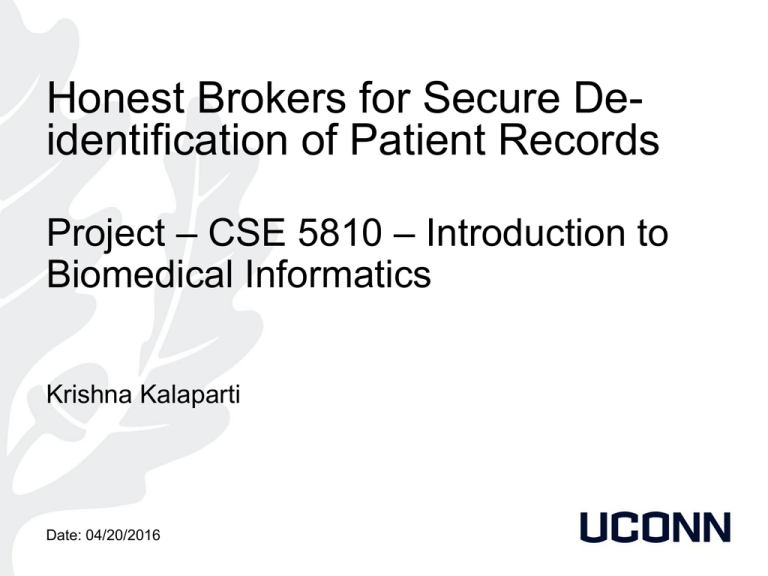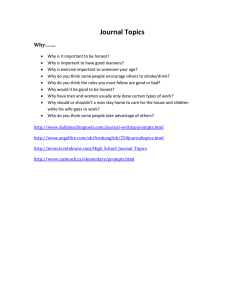Honest Brokers for Secure De- identification of Patient Records Project
advertisement

Honest Brokers for Secure Deidentification of Patient Records Project – CSE 5810 – Introduction to Biomedical Informatics Krishna Kalaparti Date: 04/20/2016 Agenda • • • • • • • Honest Brokers – Background What is a Honest Broker? What can a Honest Broker do? 21 items in PHI which should be de-identified by the Honest Broker Use of Honest Broker Creation of a Data Set Optimal Roles of the Honest Broker Review of the Honest broker system of the Ohio State University Medical Center • Summary of Honest Brokers in 10 biomedical research organizations • Future Work Honest Brokers – Background • The collection and use of human specimens have become essential to biomedical research. • Coupled with associated clinical data and the power of bioinformatics, these specimens represent an invaluable resource for current and future research on human health and disease. • At the same time, there are significant ethical, legal and social policy implications relating to the collection, storage and use of bio specimens. • Institutions, investigators, institutional review boards(IRBs), funding agencies and the public are struggling with issues like informed consent, ownership, stewardship, genetic testing and future uses that are often unspecified at the time specimens are first obtained. • The research community would benefit from federal-level guidance. Background Continued… • The HHS Secretary's Advisory Committee on Human Research Protections(SACHRP) formed a Subcommittee, which deliberated on these issues and presented its recommendations to SACHRP for further discussion and approval. • The goal of the recommendations was to provide a framework for IRBs, institutions and investigators to consider individual research scenarios without prescribing the final outcome, recognizing that those decisions will always be case-specific. What is a Honest Broker? • According to the recommendations, the following concepts have been defined: – Honest Broker: A neutral intermediary (person or system) between the individual whose tissue and data are being studied and the researcher. The honest broker collects and collates pertinent information regarding the tissue source, replaces identifiers with a code, and releases only coded information to the researcher. – Code: • is a means to identify information (such as name or social security number) that would enable the investigator to readily ascertain the identity of the individual to whom the private information or specimens pertain has been replaced with a number, letter, symbol or a combination thereof • a key to decipher the code exists, enabling linkage of the identifying information to the private information or specimens. Adapted from: http://www.hhs.gov/ohrp/sachrp/commsec/attachmentdfaq'stermsandrecommendations.pdf.pd More on Honest Broker • A Honest Broker is a neutral intermediary(person or system), who is a workforce member and is certified to collect specified health information from the tissue or data bank, remove all patient identifiers, and provide the de-identified health information or tissue to research investigators, clinicians, or other healthcare workforce members, in such a manner that it would not be reasonably possible for any individual to identify the patients directly or indirectly based on the data. • The purpose of the honest broker policy is to establish standard operating procedures for de-identification of Protected Health Information(PHI) for the purpose of safely and securely linking together or sharing clinical data to support research in compliance with HIPAA and IRB requirements. Adapted from: https://wiki.unmc.edu/index.php/Honest_Broker What can an honest broker do? • An Honest broker can provide a firewall between the investigator and the subjects' identifiable information. • For example, an honest broker could generate or receive a dataset and then strip out subject identifiers so that the data was no longer readily identifiable. They could either create a deidentified data set or a limited data set. • Additional protections for confidential information: – The honest broker can add a layer of protection to enhance the confidentiality of subjects' data and specimens. – This typically involves prospectively collected data and specimens. – For example, CAG uses the honest broker to encrypt the data and specimens collected so that the researchers are no longer able to identify the individuals from whom they were obtained. What can an honest broker do? • Converting identifiable data into data/specimens that are not readily identifiable: – When the research involves existing specimens - from clinical care or prior research - using an honest broker can alter the regulatory category of the research by providing the investigator with data and bio specimens that are not readily identifiable. – This makes the secondary use of the data/specimens not human subjects research and therefore, without requirements for prior IRB review and approval. If an investigator strips out the identifiers themselves, the research would require a determination of exemption. • If the data provided by the honest broker contains dates or zip codes then the data set is considered a limited data set/bio specimens. The data provider and the data recipient must enter into a data use agreement before the data/specimens are shared. This does not require IRB review or approval. 21 items in PHI which should be deidentified by the Honest Broker Adapted from: http://www.ncbi.nlm.nih.gov/pmc/articles/PMC4690386/pdf/peerj-03-1506.pdf Use of Honest Broker Creation of a Data Set • An honest broker is an individual who has access to the desired data by virtue of his or her Hospital responsibilities and who is not involved as a listed researcher on the respective research study. – The honest broker accesses the desired medical record information and provides the researcher with de-identified data or a limited data set. – If the honest broker is providing the researcher with a limited data set, the broker must present an internal data use agreement to the researcher prior to receiving the data set. – The honest broker can assign a code to the data, provided that the researcher does not have access to the information linking the code to the identities of the research subjects. Using the code, the researcher can request, through the honest broker, additional medical information corresponding to a given research subject. – If the honest broker provides coded data to the research but not the method to de-code the data, then the information provided will be considered de-identified or a limited data set depending upon the data elements included in the data set. Adapted from: https://irb.research.chop.edu/honest-broker Optimal Roles of the Honest Broker The Optimal roles that can be considered ideal for the Honest brokers can do the following functions: – sufficient de-identification of clinical data; – sufficient independence from any form of study team; – thorough examination of secondary use of clinical data for purposes restricted to those approved by the IRB; and – efficient provision of de-identified data to researchers. Review of the Honest broker system of the Ohio State University Medical Center The Information Warehouse at the Ohio State University Medical Center is a comprehensive repository of business, clinical, and research data from various source systems. Data collected here is a valuable resource that facilitates both translational research and personalized healthcare. The use of such data in research is governed by federal privacy regulations with oversight by the Institutional Review Board. In 2006, the Information Warehouse was recognized by the OSU IRB as an Honest Broker of clinical data, providing investigators with de-identified or limited datasets under stipulations contained in a signed data use agreement. In order to streamline this process even further, the Information Warehouse is developing a de-identified data warehouse that is suitable for direct user access through a controlled query tool that is aimed to support both research and education activities. The Information Warehouse Honest broker at the OSUMC Adapted from: http://www.ncbi.nlm.nih.gov/pmc/articles/PMC2815386/pdf/amia-f2009-370.pdf How does the Information Warehouse work at the OSUMC • Under the Honest Broker protocol implemented for the Information Warehouse at the OSUMC, a researcher typically signs a data use agreement with the IW when they request a de-identified or a limited dataset. • IW data analysts prepare the resulting data by removing PHI and deliver the dataset as a bundle of coherently linked files to the researcher. • To safeguard against accidental identification, resulting datasets with less than 25 records are not delivered, only aggregate numbers are reported to the requestor. • Re-queries based on previous results are not allowed. • De-identified codes are changed between datasets to inhibit longitudinal study of particular subjects. • Furthermore, should an inadvertent identification occur, the Data Use Agreement stipulates that the investigator will immediately seek IRB oversight. Summary of Honest Brokers in 10 biomedical research organizations Adapted from: http://www.ncbi.nlm.nih.gov/pmc/articles/PMC4690386/pdf/peerj-03-1506.pdf Future Work • Review of the implementations of the Honest Broker systems at other medical research centers. Queries? Recommending Books to Users:

